Presumed burial-place of King Antiochus
***Nemrut Dağı falls within the area hit by the two earthquakes of 2023. Miraculously, the tumulus with the heads was undamaged. However, the surrounding towns were devastated so it would not be wise to assume that a tourist visit would proceed exactly as in the past.***
In south-east Turkey, near Adiyaman, there stands a famous monument to a son who succeeded a father and then squandered his legacy. High on Nemrut Dağı (Mt Nemrut), the tumulus surrounded by the fallen heads of the statues that once adorned it is a monument not to Mithridates I Callinicus, the man who founded the small Commagene kingdom in the first century BC, but to his son, Antiochus I Theos (64-38 BC), who made the fatal mistake of siding with the Parthians against the Romans and was promptly overthrown.
Antiochus might have been forgotten by history had it not been for the excessive amour propre that led him to arrange for a burial mound (his actual grave is yet to be found) at the highest point in his kingdom, which stretched roughly from what is now Adiyaman to Gaziantep. Not even satisfied with that, he had the mound bookended with statues of some of the gods, goddesses and heroes that the Commagenes had absorbed from the Greeks and Romans, amongst them Zeus, Fortuna and Hercules, a particular favourite. Today it’s the chance to see the picturesque heads of these statues that inspires visitors to get up long before dawn and make the trek up the mountainside. In terms of the sheer pomposity of the monument the most obvious parallel in modern times is probably the shrine that General Franco had tunnelled into the hillside at Escorial in Spain.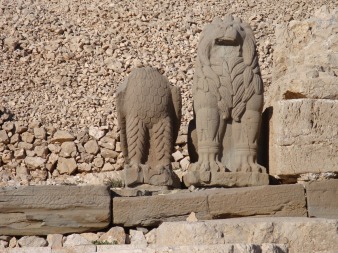
Most visitors to Turkey yearn to visit Mt Nemrut, and it has become part of traveller mythology that the visit must be made at sunrise or sunset. In fact these are probably the worst times to arrive (especially if you’re the kind of person who relishes being able to explore historical sights in peace and quiet) since noisy gaggles of tourists tend to create something of a circus atmosphere in front of the heads (which are now fenced off from visitors). Come a couple of hours after sunrise or before sunset and the odds are that you’ll have this UNESCO world heritage site to yourself.
Kahta and Adiyaman hoteliers can book you a short tour to see the heads, but really they’re only a small part of what the “mountain” has to offer. If you have the time it’s much better to book on the longer tour that takes in several other sites on the way up or down.
Note that if you visit Nemrut for sunset and then explore the other sights in the morning you will have to pay the national park entrance fee twice.
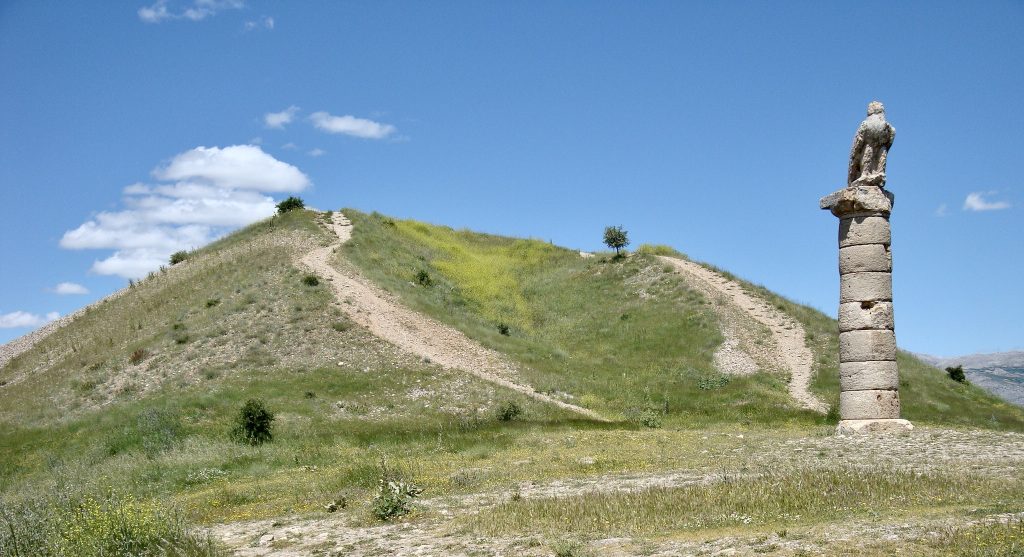
Touring the secondary sites
Starting from Kahta, you used to come first to a smaller tumulus, which was the burial mound of Antiochus’ wife, Isias. This was once ringed with pillars topped with statues and is known as Karakuş (Blackbird) after the surviving pillar that carries a statue of a bird. The view towards Nemrut and out over the Atatürk Lake from the top of the mound is simply breathtaking. Alas, the earthquakes of 2023 brought the pillar down; I don’t know if it has been rebuilt.
Tours continue to Çendere where a humpbacked bridge dating back to the reign of the Roman Emperor Septimius Severus (193-211) crosses the Cendere river. The three columns adorning it are memorials to the emperor and his second wife, and their son Caracalla; a fourth was taken down after Caracalla killed his brother, Geta. In 1997 the bridge had to be virtually rebuilt after a tanker demolished it; today a new bridge carries the traffic and only pedestrians can cross the older version.
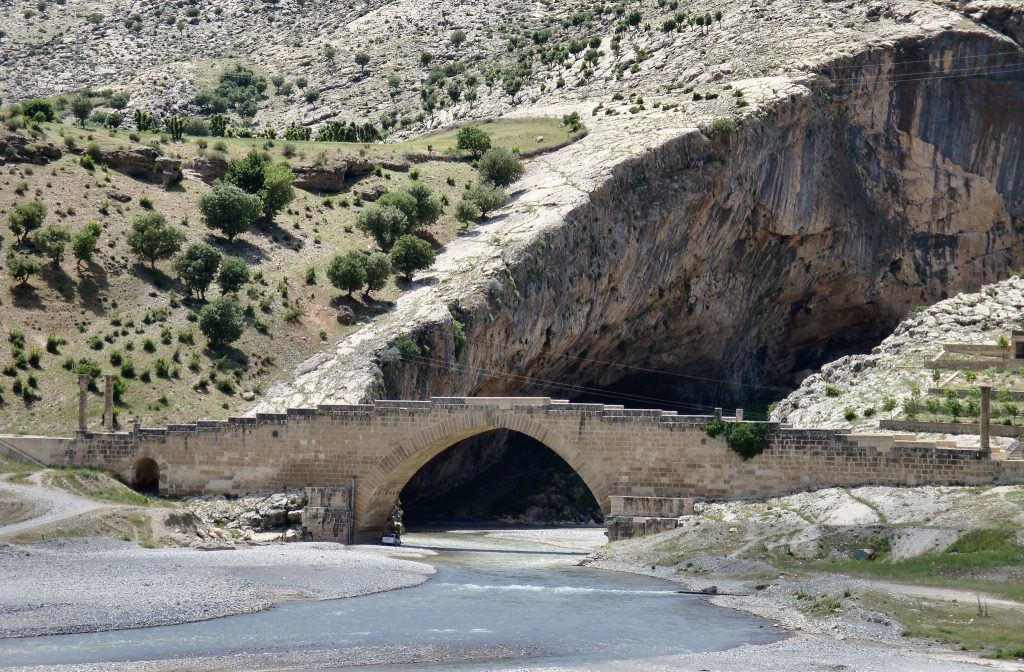
From Çendere the road continues north to another bridge dating back to Selçuk times which looks down on raging white waters and up at a ruined castle.
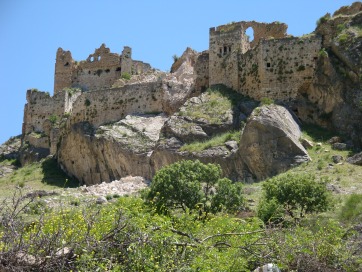 Just before it, a turning on the left leads to the site of Kocahisar/Eski Kahta (Old Kahta), a detour well worth taking since from the village you get to see the spectacular remains of the 13th-century Yeni Kale (New Castle), built by the Mamluks and reminiscent of the Crusader castles of Syria. Unfortunately it’s no longer possible to enter the ruins although you can admire them from the terrace of a pretty adobe house that was once home to a German, or from the rose-filled garden of the Café Rome.
Just before it, a turning on the left leads to the site of Kocahisar/Eski Kahta (Old Kahta), a detour well worth taking since from the village you get to see the spectacular remains of the 13th-century Yeni Kale (New Castle), built by the Mamluks and reminiscent of the Crusader castles of Syria. Unfortunately it’s no longer possible to enter the ruins although you can admire them from the terrace of a pretty adobe house that was once home to a German, or from the rose-filled garden of the Café Rome.
Finally, a fork in the road leads to the remains of Arsemeia, once the Commagene capital. Here a path runs down to a stele carved with the image of Mithras, a Persian god who had been absorbed into the Commagene belief system, then up to a cave where another stele shows Mithridates I Callinicus shaking hands with the Greek god Apollo.
Finally the path strikes up the hill and emerges in front of the jewel in the Arsemeian crown which is an undamaged stele showing Mithridates I Callinicus shaking hands with a naked Hercules who has the skin of the Nemean lion casually draped over his shoulder. Slippery steps descend into the ground, although it’s a brave person who ventures far down them in the dark.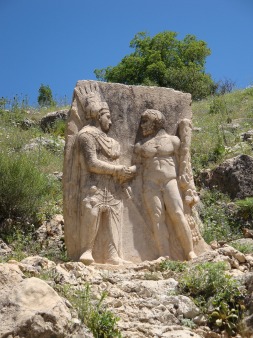 Above them a lengthy inscription suggests that the king who founded the Commagene kingdom is buried hereabouts in a grave far less ostentatious than his son’s. It seems nothing short of a miracle that these carvings should have survived intact in this exposed position for more than two thousand years.
Above them a lengthy inscription suggests that the king who founded the Commagene kingdom is buried hereabouts in a grave far less ostentatious than his son’s. It seems nothing short of a miracle that these carvings should have survived intact in this exposed position for more than two thousand years.
The lesser sites of Nemrut Dağı are impressive in their own right although what may stand out most in your memory is the spectacular mountain scenery, especially in spring when every field is bright with wildflowers.
Sleeping
Where should you base yourself to explore Nemrut Dağı?
There are hotels to suit all budgets in Kahta and some smarter, more business-oriented hotels in Adiyaman but for the real Nemrut experience you should probably stay up on the mountain itself in the village of Karadut. For comfort, you can put up in the Otel Kervansaray or the Hotel Euphrat, but many people will enjoy the more basic charms of the Karadut Pansiyon where half-board arrangements are available. There’s also a simple dormitory attached to the Café Rome.
Cafe Rome Pansiyon, Kocahisar. Tel: 0416-741 2121
Güneş Motel Nemrut. Tel: 0543-876 7271
Hotel Euphrat, Karadut. Tel: 0416-737 2175
Otel Kervansaray, Karadut. Tel: 0416-737 2190
Transport info
The nearest airports to Nemrut Dağı are in Adiyaman and Malatya.
From Kahta there are infrequent minibuses as far up the mountain as Karadut. However, that will virtually oblige you to take a tour organised by the pension, something better decided and bartered for BEFORE you get there.
Otherwise, every hotel in Adiyaman and Kahta will be able to organise a tour for you. Make sure you are clear what is and isn’t included – the national park fees, for example, are likely to be additional costs.
There is a second road up Nemrut Dağı from Malatya. Without your own car you will have to make arrangements there with a tour company (Cem Tour, tel: 0422-322 6666) or private guide. These tours normally spend the night on the mountain at the Güneş Motel. I don’t know if this is still possible after the earthquakes.
Given the complications and hassles sometimes involved in making private arrangements to visit Nemrut Dağı in Kahta another option is to sign up for a tour organised well away from the mountain, for example from Cappadocia. These tours usually take in various sights on the way to Kahta and back including a caravanserai near Kayseri, the bald ibis sanctuary at Birecik and the famous ice-cream parlour in Kahramanmaraş. In summer there are several guaranteed departures every week from Göreme with Cem Tour (Tel: 0384-271 2834), Neşe Tours (Tel: 0384-271 2525) or Turkish Heritage Travel (Tel: 0384-271 2687).
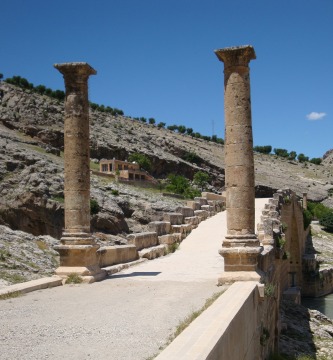
Read more: The Palan-Maker of Gerger


